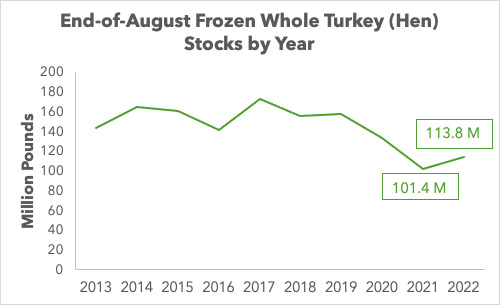Turkey talk: Alabama Extension economist says be prepared to pay more for Thanksgiving dinner
Article body
Food prices are soaring over this time last year, and even the Thanksgiving turkey is not being spared. Turkey prices are at their highest levels since 2000, adding to what is already expected to be a more expensive celebration later this month. Wendiam Sawadgo, an agricultural economist with Alabama Extension has the skinny on a why we’ll pay more this Thanksgiving.
All signs are pointing to a higher cost for a Thanksgiving dinner this year. What do families need to know?
We’ve seen turkey prices increase by about 25% over where they were this time last year reaching their highest mark since at least 2000. Wholesale turkey prices as of September reached $1.70 per pound for hens (8-16 lb.), which are the birds typically eaten for Thanksgiving dinner. At the retail level, frozen whole turkey prices averaged $1.39 per lb. in the Southeast, as of Oct. 21. This marks an increase of 40 cents per pound. compared to the same time last year. This means that this year, a 15-lb turkey would cost $20.85, compared to $14.85 for the same-sized bird last year.
Food prices in general have increased by 11.2% over last year, with food prepared at home increasing by 13.0%. Eggs have seen the largest increase, up 30.5% from 2021. Fruits and vegetables are up 10.4%, and cereals and bakery products are up 16.2%, which means all the fixings will be quite a bit more expensive this year along with the turkey.
In particular, let’s look at a grocery store list for common produce, dairy, and meat items used in Thanksgiving dishes. According to USDA data, all items listed except sweet potatoes and collard greens are more expensive than last year (table below). This is led by a 49% increase for a 5-lb. bag of red potatoes, making mashed potatoes quite a bit more costly this year. In all, this grocery list which would have cost $59.50 in 2021 would total $70.76 in 2022.
What is leading to the spike in turkey prices this year?
Market factors have driven the increase in turkey prices this year. According to the USDA, production for 2022 is projected to fall by 354 million pounds. – about a 6.4% decline – largely due to the Highly Pathogenic Avian Influenza outbreak that has seen 7.15 million turkeys lost as of early October. Rising costs of turkey production from higher feed costs due to high corn and soybean prices are another factor contributing to the higher turkey prices.
Despite the decline in turkey production, supplies aren’t expected to be low for the whole birds typically consumed for Thanksgiving. This year’s decline in turkey production follows a similar decrease last year, which led to worries over a turkey shortage in advance of last Thanksgiving. However, this might not end up being a huge concern this time around, as frozen whole hens in cold storage are up 12% from last year, totaling 113.8 million pounds as of the end of August, the time of year during which whole bird stocks typically peak in advance of the holiday season (figure below).

Do you have any advice for keeping food costs down for holiday gatherings?
Thanksgiving is the largest food consumption day of the year, so finding a way to keep costs down is important. As prices increase, browsing different grocery store ads (or their apps) to take advantage of special offers can go a long way to saving money. Planning ahead on what to buy and looking for sales on high-cost items such as turkey can help stretch your Thanksgiving dinner budget. Purchasing canned goods or frozen turkeys ahead of time can be other options if you have the space. Some stores offer deals for a discounted or free turkey with certain purchases (e.g. $100 spent), so that could be an option, especially for families that typically spend that amount on a grocery trip. But keep in mind, spending more money for a free turkey might not be worth it for everyone.
Dorothy Brandon’s tips in this article provide more advice on how to save money in times of high inflation.
What is the longer-term outlook for food supply and distribution, particularly in the Southeastern U.S.?
There are several challenges to the food supply facing the country. Highly Pathogenic Avian Influenza continues to be a threat in the U.S., especially the Southeast where broiler production is concentrated. Alabama ranks second only behind Georgia in broiler production. This threat could limit poultry production this year, affecting both producers and consumers.
High input costs from fertilizer and feed have also challenged producers this year, potentially reducing food production. These challenges follow supply-chain disruptions that have had sizeable impacts on food supply and distribution since the onset of COVID-19. Inflation has remained longer than expected and continues to affect food prices.
Auburn University is a nationally ranked land grant institution recognized for its commitment to world-class scholarship, interdisciplinary research with an elite, top-tier Carnegie R1 classification, life-changing outreach with Carnegie’s Community Engagement designation and an undergraduate education experience second to none. Auburn is home to more than 30,000 students, and its faculty and research partners collaborate to develop and deliver meaningful scholarship, science and technology-based advancements that meet pressing regional, national and global needs. Auburn’s commitment to active student engagement, professional success and public/private partnership drives a growing reputation for outreach and extension that delivers broad economic, health and societal impact.





